About 1860 the store building occupied by the Peoples Building & Loan Association was erected by Benjamin Hendricks. Isaac G. Freed, grandfather of John Freed Morris, had a machine shop where A. K. Shearer’s warehouse was located, at Second and Montgomery. On this corner in 1864 the post office was located, with Mr. Freed as the first postmaster.
About 1865 Walnut street was laid out southwest to Morris road and soon thereafter was opened northeast to the railroad. It was about 1865 that the owners of the Hurst farm began to sell building lots, and Shearer street was opened to Pennsylvania avenue. Shearer street was formerly a lane leading to the Shearer homestead, with cherry trees on each side and a big gate at Main street.
The large building next to the current fire station on South Main street dates back to 1859, when it was first erected by J. H. Egner for a grist mill and also a distillery. It measured forty by sixty feet, three stories in height, with an attic. The size of the lot was 200 by 100 feet and fronted on Main street. About the time the mill was finished the proprietor had to sell out, and it was purchased by Jonas D. Moyer, David Moyer and Elias K. Freed. The new firm removed the distillery equipment and changed that part of the building into a planing mill, the other part as a custom mill. [By way of explanation, a planing mill is a facility that takes cut and seasoned boards from a sawmill and turns them into finished dimensional lumber.]
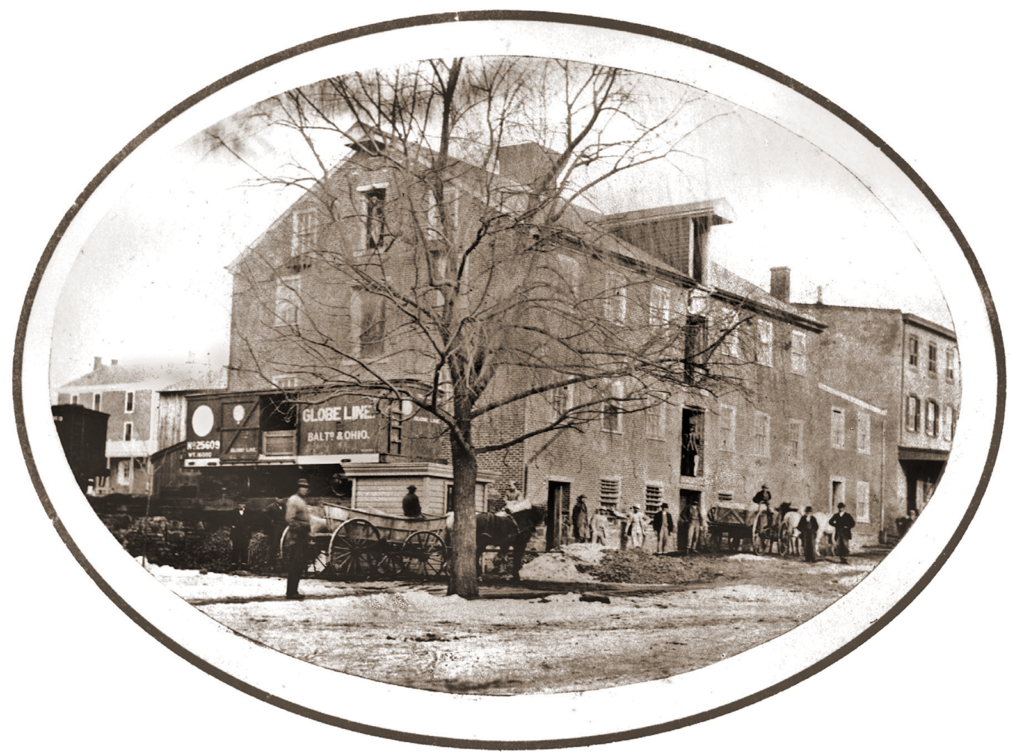
In March 1862 the building was destroyed by fire, but it was quickly rebuilt as a merchant and grist mill, with five run of stones* and a 40 horsepower coal-fired steam engine. In 1866 Jonas D. Moyer withdrew from the firm. In 1868 David Moyer also withdrew, having sold his interest to Henry W. Moyer, father of our present [1959] citizen Clinton B. Moyer. A co-partnership was then formed under the title of Elias K. Freed & Company, who operated the mill upon the old plan until 1876, when they changed the machinery and worked upon what was known as the new process.
In 1881 Mr. Moyer sold his interest to Mr. Freed, who gave a third interest in the business to his son-in-law Frank S. Kriebel. Mr. Freed took down the old mill and rebuilt it for manufacturing flour by the roller process, increasing the capacity of the mill to one hundred and fifty barrels a day. The mill then measured one hundred feet wide by forty feet deep, with three stories and an attic, with a two story warehouse. The storage capacity was twenty thousand bushels of wheat and one thousand barrels of flour. When the roller process came into operation, the firm worked day and night. This was the first roller mill in Montgomery county and the third in the state. Later, the building was occupied by the North Wales Planing Mill, and a “Five and Ten” cent store.
At the intersection of Main street with the railroad, the north corner, now the home of the North Penn Volunteer Fire Company, was a large three story stone building known as Leister’s Hardware Store and tin shop. A portion of this building also served as the office of the North Wales Record newspaper. This building was erected in 1865 by David Moyer to be used as a storage house. Moyer afterwards rented it to Sellers & Kepler for a hardware store. Sellers sold his interest to Isaac G. Freed in 1866 and the firm henceforth consisted of Freed & Kepler. Mr. Freed continued in the business until 1872 when he sold out to George W. Grove of Bucks county. A few years later it passed into the hands of A. S. Winner & Company, who held it until 1878 when Jacob Leister, grandfather of Frank H. Leister, took possession. Winner was for a time postmaster. Mr. Leister continued in this business until 1909 when he sold to V. D. Lewis and William F. Burk who then conducted the business under the name of Burk-Lewis Hardware Company.
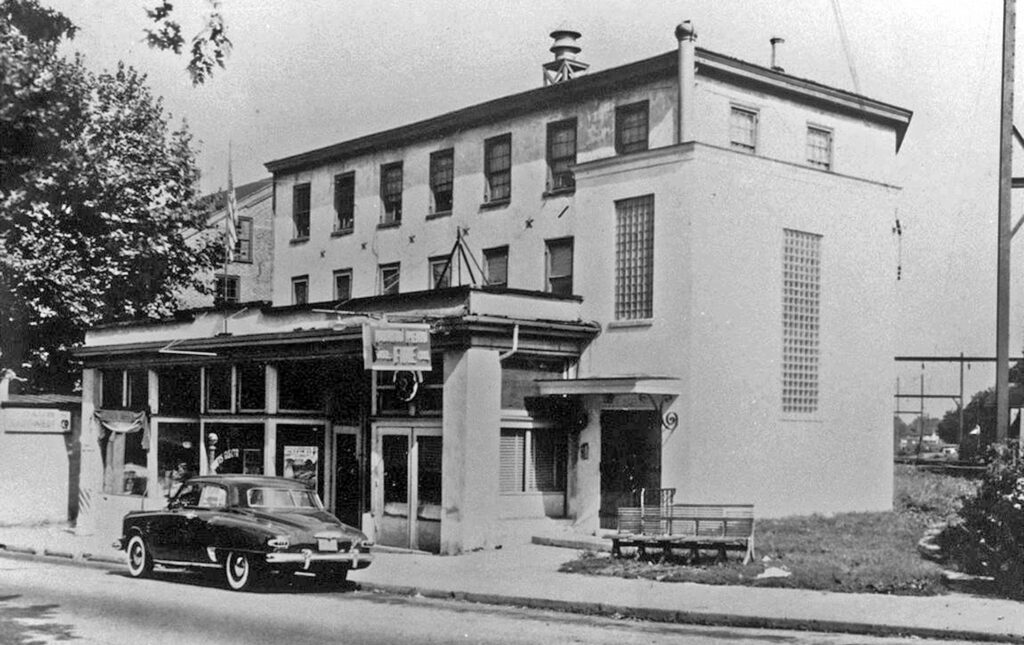
A large brick dwelling opposite the fire house was built as a store and dwelling in 1867 by William R. Bechtel. Today the North Wales Pub occupies the first floor of this building.
In 1861 Abel K. Shearer, father of Abel K. and Ralph W. Shearer established an extensive lumber business. Mr. Shearer was born on the farm of his father, Jacob, in Gwynedd township, November 6, 1838, and received his education at the schools in the vicinity, after which, until he was twenty-three years of age, he worked on his father’s farm. He then determined to embark in commercial ventures and established the lumber yard in 1861. This enterprise grew to such proportions as to make the addition of a steam powered planing mill a necessity. This he established in 1870. While mainly occupied in the management of his business, Mr. Shearer found time to devote to local political issues. He served in borough council and as a school director. He was a director of the North Wales Building and Loan Association and a member of the Lutheran Church where he served on the church council. The lumber yard was then conducted by his son Abel K. Shearer.
A harness shop was opened in the sheds to the rear of the hotel on Main street, and in the same building there was a cigar factory. In 1865 the post office was moved to the Hendricks store. A fire company had been organized and a hand engine had been purchased from Philadelphia. The engine was not a success and was later sold for scrap.
The North Wales Record newspaper was started in the hardware building of Jacob H. Leister by Milton Wood, and was printed on a Washington Hand Press. The first number was issued on August 4, 1874, and in the absence of a press, the two first numbers were printed at the office of the NEUTRALIST, in Skippackville, to which place the forms were carried in a wagon, a distance of eight miles. The paper soon acquired considerable circulation, especially in the near vicinity, but was not financally profitable to its publisher. Less than a year afterward, on June 19, 1875, Mr. Wood sold out his interest to the firm of Marlin & Smith. The paper continued to be published weekly, under various ownerships, until February 28, 1942, when the then owner and publisher, Mr. W. M. Kirkpatrick, ceased publication.
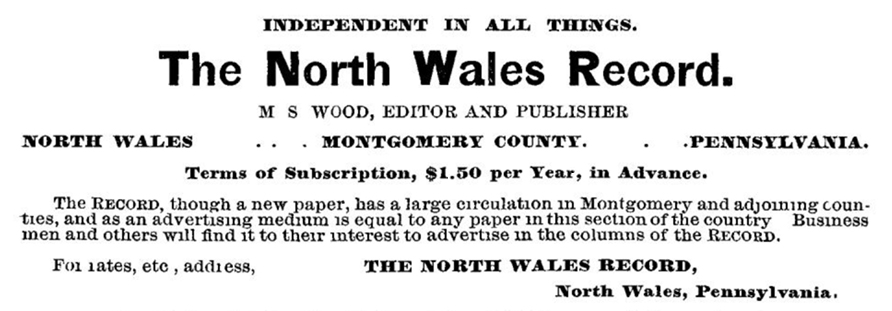
Among the advertisers in the first issue of the North Wales Record newspaper were found Harley & Brothers, merchandise; William H. Staiger, barber; Grove & Kepler, hardware; Dr. W. H. Wampole, dentist; Dr. H. B. Johnson, druggist and physician; William R. Bechtel, shoe manufacturer; Shearer, Lukens & Co., planing mill; Moyer & Shearer, lumber; J. A. Gerhart, house and sign painting; Jacob Leister, hardware store and tinsmith; Isaac Wampole, Justice of the Peace; Slutter & Bright, carriage factory; E. K. Freed & Co., millers; North Wales Academy and School of Business. Among the events published in the news was an 1880 visit from General W. S. Hancock, a candidate for President, who was royally entertained at Lukens North Wales Hotel, now the Rorer-Seems Building.
John Kuhns had commenced the erection of a large store house and hall on the corner of Second street and Montgomery avenue. The new building was to be of brick, three stories high, with a depth of 40 feet. The building faced Second street. The first floor and basement were to be used as a dry goods store, the second story to be fitted up for a public hall, and the third floor for a lodge room. Mr. Kuhns stated, in the North Wales Record of August 8, 1875, “A public hall has long been needed by our borough and our citizens will be glad to know that their wishes will be gratified when the new building is erected.” Later, this building served as a hotel known as Philadelphia House. The building no longer stands [see below].
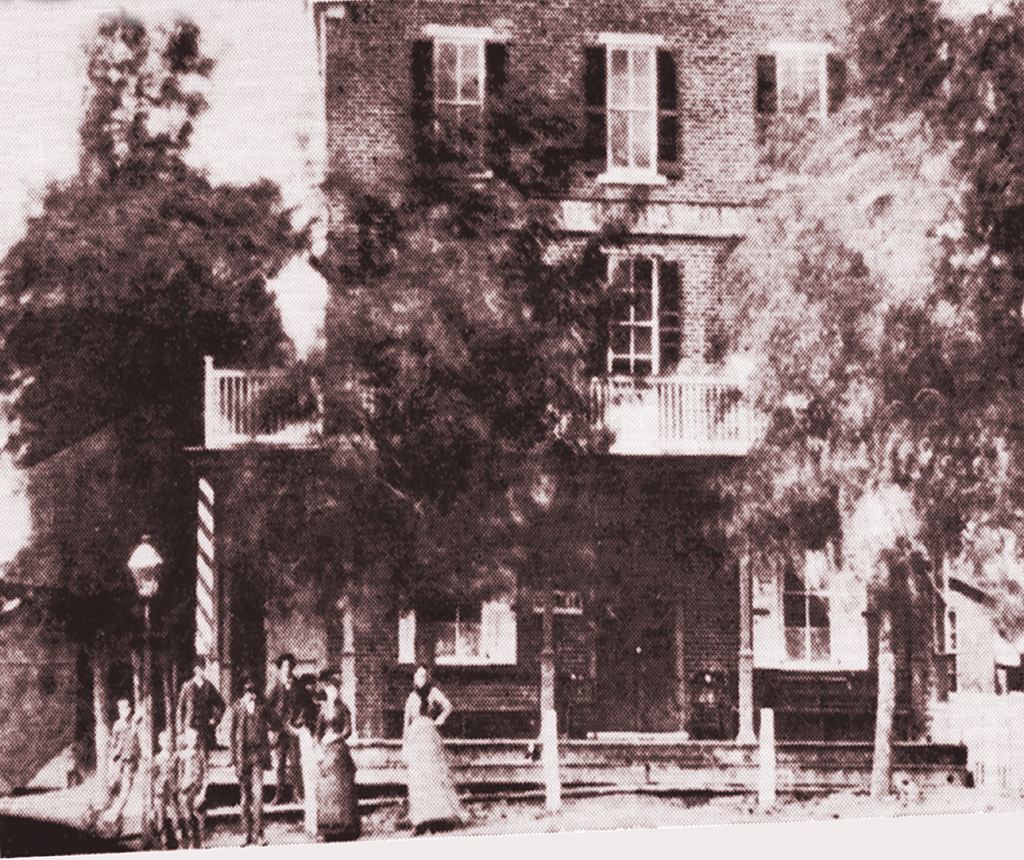
A new pottery and earthenware manufactory operated by Moyer & Young had just been completed at Pennsylvania avenue and Walnut street, and a Board of Trade was active. In 1875 North Wales borough had 470 inhabitants, of which forty were taxpayers; two public schools with 104 pupils; twelve mercantile taxpayers; three hotels; and industrial establishments.
The North Wales Academy and School of Business, with Professor Samuel U. Brunner, father of J. Reiff Brunner, principal, was now located in its new home on Pennsylvania avenue. Previous to this, the school was located on Main street in the present [1959] home of Dr. E. W. Olson. This institution first opened in Kulpsville, Penna. on October 14, 1867, its object being “to meet the increasing demand for practically educated men and women.” The school moved to North Wales April 10, 1871, and the school building was erected in 1872. During mid-20th century the former academy building served as the American Legion Donald McLeod Post, No. 336. Later, the building was torn down and six houses were built on the lot.
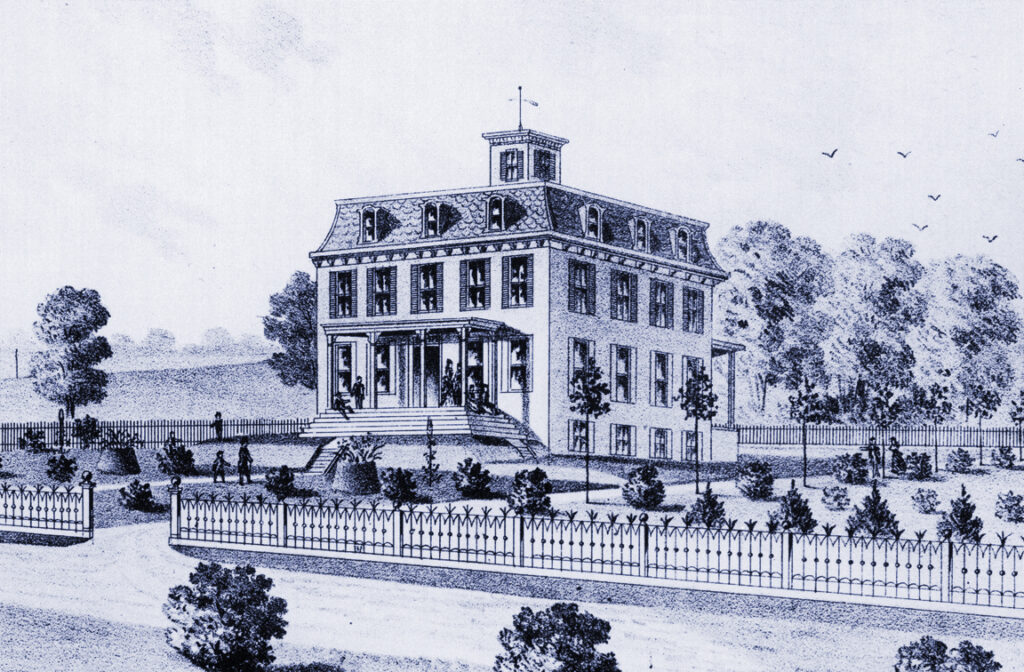
The first issue of our local paper, the North Wales Record, on August 8, 1874 had this to say about the North Wales Academy: “The North Wales Academy and School of Business opens its fall term of 13 weeks on September 7th. The principal, S. U. Brunner is receiving the encouragement he deserves for the indefatigable efforts put forth in raising the standard of education in our midst. The academy deserves the success it is attaining, none of its many pupils, graduates and friends will deny. Being so admirably situated in the southern suburbs of our beautiful borough, with all necessary appliances of a first class boarding school, together with its able instructors, destines it to become one of our leading educational institutions in this section of the state.”
This post is sourced from a column entitled Early North Wales: Its History and Its People penned by long-time North Wales resident historian Leon T. Lewis. The article appeared in its original form in the May 5, 1959 issue of the North Penn Reporter.
*Run of millstones or stones — a set of two millstones, consisting of an upper “runner” millstone and the lower “bed” stone. (Also called a Pair of Stones.)
